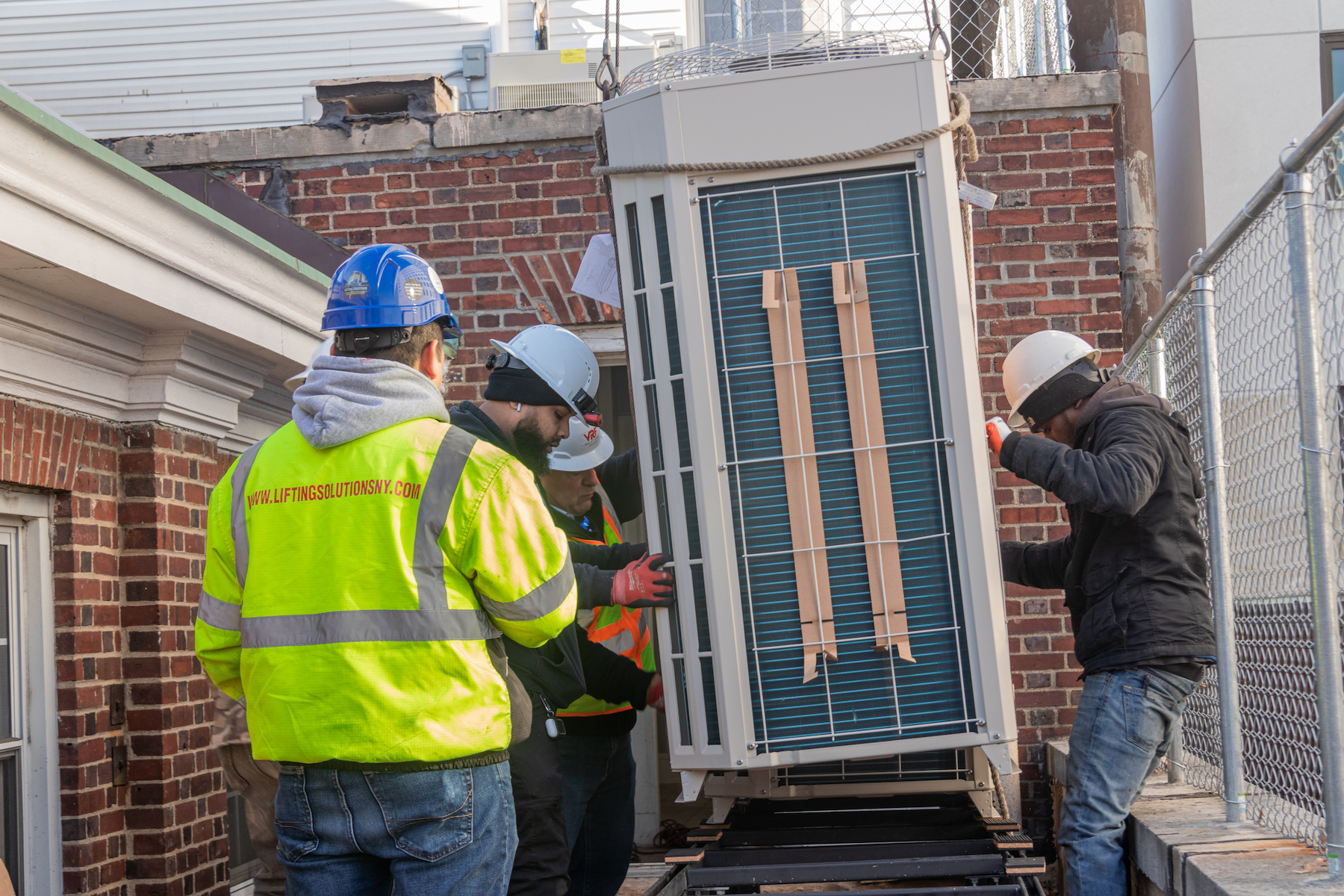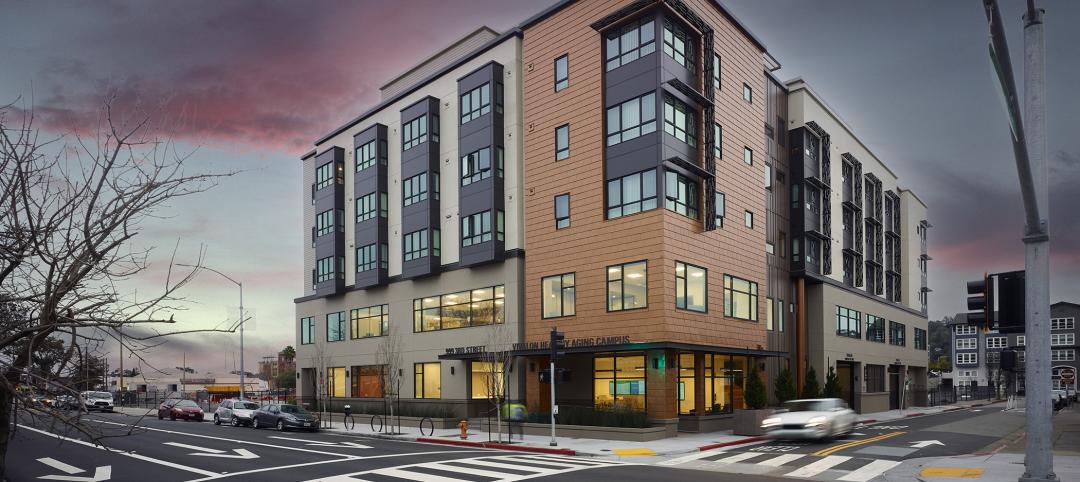Conversations about creating more efficient homes often revolve around new construction. But what about the many more buildings that already exist? Residential and commercial buildings account for 13% of greenhouse emissions in the U.S. That’s precisely what BlocPower aims to address.
BlocPower electrifies and decarbonizes buildings—mostly by replacing oil- and gas-based furnaces, boilers, and other products with all-electric heating, cooling, and hot-water systems. Founded by Donnel Baird in 2014, the Brooklyn, N.Y.-based company works with building owners and city governments to make buildings greener and healthier. As of April, BlocPower had raised over $100 million, including over $50 million from Goldman Sachs and $30 million from Microsoft’s Climate Innovation Fund.
In what BlocPower calls the “first large-scale city electrification initiative,” the company plans to electrify all 6,000 buildings in the city of Ithaca, N.Y. If successful, BlocPower will reduce Ithaca’s annual carbon dioxide emissions by 40%. BlocPower has a similar agreement with Menlo Park, Calif., where the company will help electrify over 10,000 homes and buildings by 2030.
WHOLE-HOME ELECTRIFICATION OF RETROFITS
“BlocPower is turning every home into the equivalent of a Tesla,” Fast Company announced earlier this year, ranking BlocPower #4 on its list of the most innovative companies in the world. Time called BlocPower one of the world’s most influential companies.
BlocPower provides a turnkey service. First, for each building, the company identifies the energy-efficiency solutions that would have the greatest impact. BlocPower then presents the building owner with its list of possible measures and an analysis of their impact. “We show building owners the costs and the benefits of these green-efficiency projects,” says Maria Carrillo, project operations manager, BlocPower. The company’s retrofits save 20% to 40% on energy bills annually, Carrillo says.

Once the owner picks the solutions they want, BlocPower finances the project, typically through a 15-year lease without a down payment, and competitively bids out the work to contractors who can execute green projects. The lease covers the upfront costs—design, materials, and labor—as well as BlocPower’s ongoing maintenance of the equipment. “We wrap in a lot of benefits into the lease option to make clean energy more accessible to building owners,” Carrillo says.
The main green tech that BlocPower provides? Electric air-source heat pumps. The confusingly named heat pump, popular in parts of Asia and Europe but much less so in the U.S., doesn’t just heat a home but also cools it. In the summer, air-source heat pumps suck out and cool hot air in the home, and in the winter, they grab and warm heat energy from the outside air. “Heat pumps are at the core of most of our building projects,” Carrillo says. “They deliver the most bang for the buck when it comes to efficiency and overall impact on the building.”
BlocPower’s other offerings include electric water heaters, solar panels, air sealing, electric stoves, highly insulated building envelopes—and the electrical upgrades that almost all buildings need for many energy-efficiency solutions to work.

So far, BlocPower has electrified over 1,200 buildings, mostly single-family and multifamily homes primarily in low- and moderate-income communities, though the company also has worked on commercial buildings and houses of worship.
The company’s biggest challenge is one shared by many in the construction industry: the labor shortage. For BlocPower, the worker shortage is exacerbated by the fact that it needs laborers with green-construction knowhow. “The biggest barrier we have is the green workforce that actually constructs these projects. There’s a lack of workforce and skill. And it’s very fragmented,” Carrillo says. On each project, BlocPower often works with four to six different companies, each with its own specialty. “We’re limited by the contractors across the country that can pick up the work and have the skills to green these buildings.”
To help address that challenge, BlocPower, in partnership with the City of New York, has created a workforce development agency called Civilian Climate Corps. Based in New York, the agency builds and trains a pipeline of up to 1,500 workers who come from areas impacted by higher rates of gun violence. These individuals learn in the classroom and on the job, gaining the skills and certifications they need. Hopefully, Carrillo says, they will continue to work in green construction, perhaps as BlocPower’s contractors.
Related Stories
Senior Living Design | May 16, 2024
Healthy senior living campus ‘redefines the experience of aging’
MBH Architects, in collaboration with Eden Housing and Van Meter Williams Pollack LLP, announces the completion of Vivalon’s Healthy Aging Campus, a forward-looking project designed to redefine the experience of aging in Marin County.
Sustainability | May 10, 2024
Perkins&Will’s first ESG report discloses operational performance data across key metrics
Perkins&Will recently released its first ESG report that discloses the firm’s operational performance data across key metrics and assesses its strengths and opportunities.
Sustainable Development | May 10, 2024
Nature as the city: Why it’s time for a new framework to guide development
NBBJ leaders Jonathan Ward and Margaret Montgomery explore five inspirational ideas they are actively integrating into projects to ensure more healthy, natural cities.
K-12 Schools | May 7, 2024
World's first K-12 school to achieve both LEED for Schools Platinum and WELL Platinum
A new K-12 school in Washington, D.C., is the first school in the world to achieve both LEED for Schools Platinum and WELL Platinum, according to its architect, Perkins Eastman. The John Lewis Elementary School is also the first school in the District of Columbia designed to achieve net-zero energy (NZE).
K-12 Schools | Apr 30, 2024
Fully electric Oregon elementary school aims for resilience with microgrid design
The River Grove Elementary School in Oregon was designed for net-zero carbon and resiliency to seismic events, storms, and wildfire. The roughly 82,000-sf school in a Portland suburb will feature a microgrid—a small-scale power grid that operates independently from the area’s electric grid.
75 Top Building Products | Apr 22, 2024
Enter today! BD+C's 75 Top Building Products for 2024
BD+C editors are now accepting submissions for the annual 75 Top Building Products awards. The winners will be featured in the November/December 2024 issue of Building Design+Construction.
Codes and Standards | Apr 12, 2024
ICC eliminates building electrification provisions from 2024 update
The International Code Council stripped out provisions from the 2024 update to the International Energy Conservation Code (IECC) that would have included beefed up circuitry for hooking up electric appliances and car chargers.
Codes and Standards | Apr 8, 2024
First federal blueprint to decarbonize U.S. buildings sector released
The Biden Administration recently released “Decarbonizing the U.S. Economy by 2050: A National Blueprint for the Buildings Sector,” a comprehensive plan to reduce greenhouse-gas (GHG) emissions from buildings by 65% by 2035 and 90% by 2050.
Green | Apr 8, 2024
LEED v5 released for public comment
The U.S. Green Building Council (USGBC) has opened the first public comment period for the first draft of LEED v5. The new version of the LEED green building rating system will drive deep decarbonization, quality of life improvements, and ecological conservation and restoration, USGBC says.
Codes and Standards | Apr 8, 2024
Boston’s plans to hold back rising seawater stall amid real estate slowdown
Boston has placed significant aspects of its plan to protect the city from rising sea levels on the actions of private developers. Amid a post-Covid commercial development slump, though, efforts to build protective infrastructure have stalled.

















